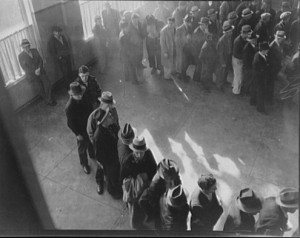- Home
- News
- Features
- Topics
- Labor
- Management
- Opinions/Blogs
- Tools & Resources
Applications For Unemployment Benefits Fall Again, Now At 323,000
By METEOR BLADES, Daily Kos Labor— The Department of Labor reported Thursday, May 9, 2013, that seasonally adjusted, first-time applications for unemployment compensation fell again.
For the week ending May 4, claims fell to 323,000, down 4,000 from the previous week’s revised figure of 327,000, originally reported as 324,000. For the comparable week of 2012, 366,000 jobless Americans filed first-time claims.
The four-week running average, which flattens the volatility of the weekly numbers, fell 6,250 to 336,750 from the revised average of 343,000.
During the best economic year of the Clinton administration, first-time claims averaged about 280,000 a week.
For all programs, state and the federally funded “emergency” extensions, there were, for the week ending April 20, 4,874,526 people making claims.
For the comparable week of 2012, 6,423,153 people were making claims.
Less than 40% of the unemployed are now receiving benefits compared with around 70% when the impact of the Great Recession was at its worst.
Some 1.77 million Americans are receiving federally funded benefits under the Emergency Unemployment Compensation provisions put in place because of the recession.
Those receiving EUC benefits are seeing their checks slashed at least 10% because of the sequester.
In California, the cut is 17.5%. The cuts don’t affect those receiving state benefits, which is the category that all the approved first-time applicants fall into.
But the sequester is also reducing the amount of administrative assistance state employment programs provide.
The drop in overall numbers receiving employment compensation is partly because people have found jobs and no longer need the benefits and partly because some people have exhausted their benefits and now receive nothing.
How many of that latter category have given up looking for a job altogether isn’t known.
But it’s obvious that someone who has been on unemployment compensation for a year or more looking for work each week without finding any is more likely than not to give up the search entirely unless the job market improves significantly.
And giving up even though they still want a job means they don’t get counted as being in the labor market and, therefore, aren’t included in tallying the official unemployment rate, which is now 7.5%.
The practice of dropping them from the rolls, even though they want jobs, distorts the overall unemployment picture.
Although the seasonally adjusted job gains reported by the Bureau of Labor Statistics last Friday was considerably better than expected at 165,000, that’s slightly down from the 168,000 monthly average for the previous 12 months.
So, while layoffs of compensation-eligible workers continues to drop, hiring is still far weaker than needed to quickly get the employment rate back to where it was in December 2007, that being 5%.
In fact, at the current rate of hiring, it would take five more years to return to that rate.
What none of these statistics tell us is how good the jobs being offered are.
Part-time employment rose this month and those jobs are counted the same as full-time jobs in the BLS’s “headline” numbers.
Full time or part time, one thing we know is that, when adjusted for inflation, the average non-farm worker’s wages have risen less than 50 cents-an-hour since 2007.
That stagnation is not merely a product of the recession and its aftermath but reflects a chronic, decades-long problem that most policymakers seem completely oblivious to.
Please subscribe to WWOW’s post by email:[subscribe2]
List your business in the premium web directory for free This website is listed under Human Resources Directory





